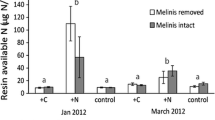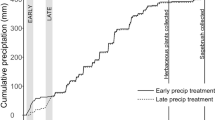Abstract
The invasion of European perennial grasses represents a new threat to the native coastal prairie of northern California. Many coastal prairie sites also experience anthropogenic nitrogen (N) deposition or increased N availability as a result of invasion by N-fixing shrubs. We tested the hypothesis that greater seedling competitive ability and greater responsiveness to high N availability of exotic perennial grasses facilitates their invasion in coastal prairie. We evaluated pairwise competitive responses and effects, and the occurrence of asymmetrical competition, among three common native perennial grasses (Agrostis oregonensis, Festuca rubra, and Nassella pulchra) and three exotic perennial grasses (Holcus lanatus, Phalaris aquatica, and Festuca arundinacea), at two levels of soil N. We also compared the root and shoot biomass and response to fertilization of singly-grown plants, so we could evaluate how performance in competition related to innate plant traits. Competitive effects and responses were negatively correlated and in general varied continuously across native and exotic species. Two exceptions were the exotic species Holcus, which had large effects on neighbors and small responses to them, and competed asymmetrically with all other species in the experiment, and the native grass Nassella, which had strong responses to but little effect on neighbors, and was out-competed by all but one other species in the experiment. High allocation to roots and high early relative growth rate appear to explain Holcus’s competitive dominance, but its shoot biomass when grown alone was not significantly greater than those of the species it out-competed. Competitive dynamics were unaffected by fertilization. Therefore, we conclude that seedling competitive ability alone does not explain the increasing dominance of exotic perennial grasses in California coastal prairie. Furthermore, since native and exotic species responded individualistically, grouping species as ‘natives’ and ‘exotics’ obscured underlying variation within the two categories. Finally, elevated soil N does not appear to influence competition among the native and exotic perennial grasses studied, so reducing soil N pools may not be a critical step for the restoration of California coastal prairie.
Similar content being viewed by others
References
Aerts R.R., Boog G.A., van der Aart P.J.M. (1991) The relation between above- and belowground biomass allocation patterns and competitive ability. Oecologia 87:551–559
Anderson L., DiTomaso J., Hrusa G.F., Rejmanek M. (1999) The CalEPPC List: Exotic Pest Plants of Greatest Ecological Concern in California. California Invasive Plant Council, Berkeley
Barger N.N., D’Antonio C.M., Thaura G., Cuevas E. (2003) Constraints to colonization and growth of the African grass, Melinis minutiflora, in a Venezuelan savanna. Plant Ecol. 167:31–43
Carino D.A., Daehler C.C. (2002) Can inconspicuous legumes facilitate alien grass invasion? Partridge peas and fountain grass in Hawai’i. Ecography 25:31–41
Casper B.B., Jackson R.B. (1997) Plant competition underground. Ann. Rev. Ecol. Syst. 28: 545–270
Corbin J.D., D’Antonio C.M. (2004) Can carbon addition increase competitiveness of native grasses? A case study from California. Restor. Ecol. 12: 36–43
Davis M.A., Pelsor M. (2001) Experimental support for a resource-based mechanistic model of invasibility. Ecol. Lett. 4:421–428
Davis M.A., Thompson K., Grime J.P. (2001) Charles S. Elton and the dissociation of invasion ecology from the rest of ecology. Divers. Distrib. 7:97–102
Freckleton R.P., Watkinson A.R. (2001) Predicting competition coefficients for plant mixtures: reciprocity, transitivity and correlations with life-history traits. Ecol. Lett. 4:348–357
Gibson D.J., Connolly J., Hartnett D.C., Weidenhamer J.D. (1999) Designs for greenhouse studies of interactions between plants. J. Ecol. 87:1–16
Goldberg D.E., Barton A.M. (1992) Patterns and consequences of interspecific competition in natural communities: a review of field experiments with plants. Am. Nat. 139:771–801
Goldberg D.E. (1996) Competitive ability: definitions, contingency and correlated traits. Phil. Trans. R. Soc. Lond. B 351:1377–1385
Goldberg D.E., Werner P.A. (1983) Equivalence of competitors in plant communities: a null hypothesis and a field experimental approach. Am. J. Bot. 70:1098–1104
Grime J.P. (1979) Plant Strategies and Vegetative Processes. John Wiley & Sons, Ltd., Chichester
Grime J.P., Campbell B.D., Mackey J.M.l., Crick J.C. (1991) Root plasticity, nitrogen capture and competitive ability. In: Atkinson D. (eds) Plant Root Growth: an Ecological Perspective. Blackwell Scientific Publications, Oxford, pp 381–397
Gurevitch J., Wilson P., Stone J.L., Teese P., Stoutenburgh R.J. (1990) Competition among old-field perennials at different levels of soil fertility and available space. J. Ecol. 78:727–744
Hager H.A. (2004) Competitive effect versus competitive response of invasive and native wetland plant species. Oecologia 139:140–149
Hamilton J.G. (1997) Changing perceptions of pre-European grasslands in California. Madrono 44: 311–333
Hatch D.A., Bartolome J.W., Fehmi J.S., Hillyard D.S. (1999) Effects of burning and grazing on a coastal California grassland. Restor. Ecol. 7:376–381
Haubensak K.A. 2001. Invasion and impacts of nitrogen-fixing shrubs Genista monspessulana and Cytisus scoparius in grasslands of Washington and coastal California. Ph.D. Dissertation, University of California, Berkeley.
Heady H. (1988) Valley grassland. In: Barbour M.G., Major J. (eds) Terrestrial Vegetation of California. California Native Plant Society, Sacramento, pp 491–514
Hickman J.C. (ed.). (1993) The Jepson Manual: Higher Plants of California. University of California Press, Berkeley
Holstein G. (2001) Pre-agricultural grassland in central California. Madroño 48: 253–264
Huenneke L.F., Hamburg S.P., Koide R., Mooney H.A., Vitousek P.M. (1990) Effects of soil resources on plant invasion and community structure in California serpentine grassland. Ecology 71: 478–491
Huntsinger L.H., McClaran M.P, Dennis A., Bartolome J.W. (1996) Defoliation response and growth of Nassella pulchra (A. Hitchc.) Barkworth from serpentine and non-serpentine populations. Madroño 43:46–57
Keddy P., Nielsen K., Weiher E., Lawson R. (2002) Relative competitive performance of 63 species of terrestrial herbaceous plants. J. Veg. Sci. 13:5–16
Kolb A., Alpert P., Enters D., Holzapfel C. (2002) Patterns of invasion within a grassland community. J. Ecol. 90:871–881
Kotanen P.M. (1997) Effects of experimental soil disturbance on revegetation by natives and exotics in coastal Californian meadows. J. Appl. Ecol. 34: 631–644
Levine J.M., D’Antonio C.M. (1999) Elton revisited: a review of evidence linking diversity and invasibility. Oikos 87: 15–26
Limpens J., Berendse F., Klees H. (2003) N deposition affects N availability in interstitial water, growth of Sphagnum and invasion of vascular plants in bog vegetation. New Phytol. 157:339–347
Lowe P.N., Lauenroth W.K., Burke I.C. (2003) Effects of nitrogen availability on competition between Bromus tectorum and Bouteloua gracilis. Plant Ecol. 167:247–254
Maron J.L., Connors P.G. (1996) A native nitrogen-fixing shrub facilitates weed invasion. Oecologia 105: 302–312
Moore D.S., McCabe G.P. (1999) Introduction to the Practice of Statistics, 3rd ed. W.H. Freeman and Company, New York
Peart D.R. (1989) Species interactions in a successional grassland. III. Effects of canopy gaps, gopher mounds, and grazing on colonization. J. Ecol. 77: 267–289
Reynolds H.L., D’Antonio C. (1996) The ecological significance of plasticity in root weight ratio in response to nitrogen: Opinion. Plant Soil 185: 75–97
Roxburgh S.H., Wilson J.B. (2000) Stability and coexistence in a lawn community: mathematical prediction of stability using a community matrix with parameters derived from competition experiments. Oikos 88: 395–408
Schippers P., Snoeijing I., Kropff M.J. (1999) Competition under high and low nutrient levels among three grassland species occuppying different positions in a successional sequence. New Phytol. 143:547–559
Siemann E., Rogers W.E. (2003) Changes in light and nitrogen availability under pioneer trees may indirectly facilitate tree invasions of grasslands. J. Ecol. 91:923–931
Sousa W.P. (1984) The role of disturbance in natural communities. Ann. Rev. Ecol. Syst. 15: 353–391
Stromberg M.R., Kephart P., Yadon V. (2001) Composition, invasibility, and diversity in coastal California grasslands. Madroño 48:236–252
Underwood A.J. (1986) The analysis of competition by field experiments. In: Kikkawa J. and Anderson D.J. (eds) Community Ecology: Pattern and Process. Blackwell Publishing, Oxford, pp 240–268
Van der Werf A., van Nuenen M., Visser M.J., Lambers H. (1993) Contribution of physiological and morphological plant traits to a species; competitive ability at high and low nitrogen supply. Oecologia 94: 434–440
Weigelt A., Jolliffe P. (2003) Indices of plant competition. J. Ecol. 91: 707–720
Weiss S.B. (1999) Cars, cows, and checkerspot butterflies: nitrogen deposition and management of nutrient-poor grasslands for a threatened species. Conserv. Biol. 13: 1476–1486
Zar J.H. (1999) Biostatistical analysis, 4th edition. Simon & Schuster, Upper Saddle River
Acknowledgements
This research was supported by grants from the Marin Community Foundation and the National Science Foundation (DEB 9910008), and by a faculty research grant to C. D’Antonio. The authors would like to thank the D’Antonio lab group for feedback, the staff of the Gill Tract Greenhouses at UC Berkeley for logistical support, and Josh Miner, Karen Haubensak and Yingssu Tsai for assistance during harvesting. We also thank two anonymous reviewers for helpful comments on an earlier manuscript draft.
Author information
Authors and Affiliations
Corresponding author
Rights and permissions
About this article
Cite this article
Thomsen, M., Corbin, J. & D’Antonio, C. The effect of soil nitrogen on competition between native and exotic perennial grasses from northern coastal California. Plant Ecol 186, 23–35 (2006). https://doi.org/10.1007/s11258-006-9109-4
Received:
Accepted:
Published:
Issue Date:
DOI: https://doi.org/10.1007/s11258-006-9109-4




